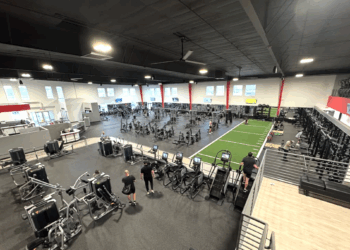For this executive spotlight, Club Solutions sat down with Rob Rideout, the vice president of sales at MicroFit, to talk about his experiences in the fitness industry.
What is your current assessment of corporate wellness in today’s health clubs?
RR: Health club-sponsored corporate wellness programs are not new and many successful owner/operators have taken advantage of this market for years because they understand its potential for both growth and sustainability. There has been plenty of research on the subject, and wellness is a hot topic. Most fitness industry conferences now have “wellness tracks” where you can learn more, and the February 2018 feature article in Club Solutions explains how Dr. Kenneth Cooper was able to overcome many obstacles to prove that a comprehensive medical/fitness evaluation is the first step toward achieving a state of superior health and well-being when followed up with the right lifestyle modification changes. He rightly concluded regular exercise, tracking and proper health coaching will increase motivation, compliance and healthy outcomes. In my opinion, this “Cooperization” effect has been the major contributor to our modern day wellness programming, and the basis of our recognition that exercise is medicine.
What best practices would you offer to health clubs to implement a successful wellness program?
RR: First, club operators should recognize that offering a sound wellness program to local companies is more about the staffing requirements than their facilities. Wellness is a very broad term and there are several components to it which are often shown in some sort of “wellness wheel” or pie chart. Wellness strategies are primarily education-based and your staff needs to be well trained in order to help individuals achieve their wellness objectives.
Secondly, wellness is not some sort of catchy marketing slogan to sell corporate clients a discounted membership package, which was often the case when I started in the industry. Now, the good news is most health clubs already offer nicer workout facilities than local companies can provide, as well as the opportunity to workout safely in a variety of individual or group settings. This environment can clearly be one of the best places to learn about and practice wellness behaviors with long-term benefits.
What mistakes do you see clubs making when it comes to this?
RR: As implied above, owner/operators need to invest as much in their staff as they do in their facilities. This means hiring qualified individuals who are willing to be properly trained to execute their overall wellness programming objectives. Creating a team approach with incentives and personal accountability built into their game plan will drive positive results. Conversely, the lack of qualified staff and training is the biggest obstacle to achieving a successful wellness program.
How can MicroFit help clubs with supporting successful wellness programs?
RR: Since 1986, MicroFit has provided comprehensive, yet easy-to-use fitness and wellness technology solutions for several thousand customers, namely health clubs, colleges-universities, fortune 500 companies, medical Fitness facilities, parks and recreation districts, first responders, our entire U.S. military and many other governmental agencies. Our standalone HealthWizard software suite offers both fitness and wellness screenings that record and track evidenced-based outcomes, which are an essential component of a properly run wellness program. We also offer our popular PC integrated medical grade FAS-2 System and other less expensive testing equipment options when required. Our focus has always been on wellness and our co-founders come directly from the same academic, medical and practical backgrounds required to initiate and execute successful wellness programs.
Is there anything else surrounding corporate wellness you’d like to share?
RR: My 1982 fitness resource, “Corporate Wellness Guide: A Strategy for Keeping Your Company Fit,” helped us introduce our onsite wellness program to a variety of clients. Many of the principles presented are just as relevant today as they were 36 years ago.
Stay ahead in the fitness industry with exclusive updates!
Rachel Zabonick-Chonko is the editor-in-chief of Club Solutions Magazine. She can be reached at rachel@peakemedia.com.











